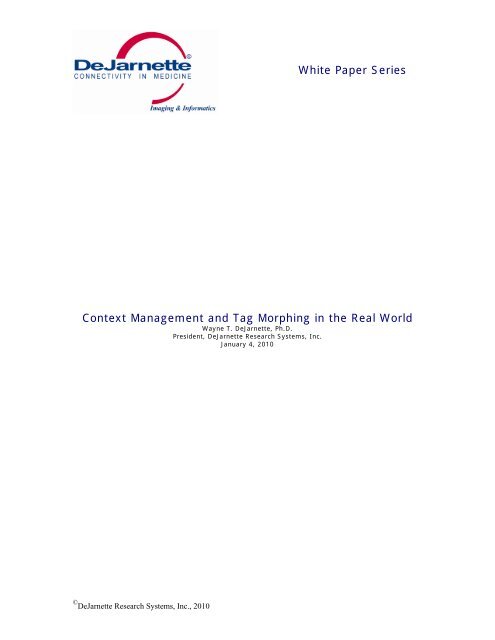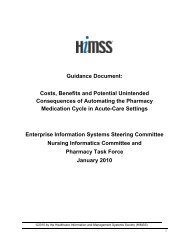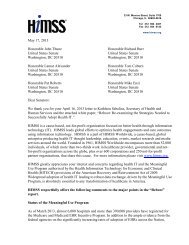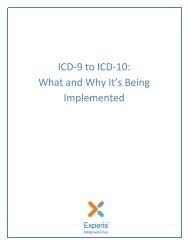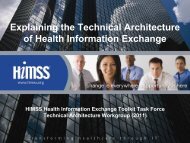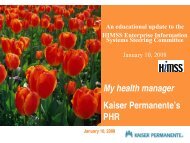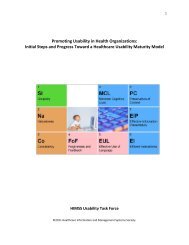Context Management and Tag Morphing in the Real World
Context Management and Tag Morphing in the Real World
Context Management and Tag Morphing in the Real World
Create successful ePaper yourself
Turn your PDF publications into a flip-book with our unique Google optimized e-Paper software.
White Paper Series<br />
<strong>Context</strong> <strong>Management</strong> <strong>and</strong> <strong>Tag</strong> <strong>Morph<strong>in</strong>g</strong> <strong>in</strong> <strong>the</strong> <strong>Real</strong> <strong>World</strong><br />
Wayne T. DeJarnette, Ph.D.<br />
President, DeJarnette Research Systems, Inc.<br />
January 4, 2010<br />
© DeJarnette Research Systems, Inc., 2010
A debate is currently rag<strong>in</strong>g <strong>in</strong> <strong>the</strong> medical imag<strong>in</strong>g <strong>and</strong> DICOM connectivity worlds. This debate<br />
has been brought about by <strong>the</strong> recent <strong>in</strong>terest <strong>in</strong> Vendor Neutral Archive products. The debate is<br />
over <strong>the</strong> need for what is referred to as “tag morph<strong>in</strong>g” functionality when specify<strong>in</strong>g an image<br />
archive. “<strong>Tag</strong> morph<strong>in</strong>g” is <strong>the</strong> ability to retrieve an image or study from <strong>the</strong> archive <strong>in</strong> a fashion<br />
such that one or more of <strong>the</strong> DICOM elements (metadata fields) are created, deleted or<br />
manipulated to provide new value(s) for <strong>the</strong> DICOM element(s) so as to make <strong>the</strong> retriev<strong>in</strong>g<br />
DICOM equipment function properly.<br />
The History of “<strong>Tag</strong> <strong>Morph<strong>in</strong>g</strong>”<br />
The concept of “tag morph<strong>in</strong>g” is more than 25 years old. It predates <strong>the</strong> existence of <strong>the</strong> DICOM<br />
st<strong>and</strong>ard. In <strong>the</strong> early days of digital medical imag<strong>in</strong>g, it was not uncommon to want to acquire<br />
image data from modalities of different manufacturers <strong>and</strong> provide some useful process<strong>in</strong>g<br />
capability for that data. Common early external applications <strong>in</strong>cluded multi-planar reconstruction,<br />
radiation <strong>the</strong>rapy plann<strong>in</strong>g, dental implant plann<strong>in</strong>g, etc.<br />
In each application case, it was required that <strong>the</strong> image <strong>and</strong> demographic data be acquired <strong>in</strong> <strong>the</strong><br />
modality’s native image format <strong>and</strong> converted to some “common format” for <strong>in</strong>put to <strong>the</strong><br />
process<strong>in</strong>g application. Each vendor of add-on-equipment had <strong>the</strong>ir own “common format” for<br />
use by <strong>the</strong>ir application.<br />
The ACR-NEMA 1 V1 <strong>and</strong> V2 st<strong>and</strong>ards were an attempt by <strong>the</strong> ACR to st<strong>and</strong>ardize on an “image<br />
transfer format” <strong>and</strong> electronic transfer protocol so that <strong>in</strong>terface development for <strong>the</strong>se third-party<br />
applications would be lessened. While this st<strong>and</strong>ardization attempt improved <strong>the</strong> situation, it did<br />
not completely elim<strong>in</strong>ate <strong>the</strong> need to underst<strong>and</strong> each vendor’s modality “image transfer format”.<br />
Modality vendors made use of <strong>the</strong> ACR-NEMA st<strong>and</strong>ard, but, due to limitations <strong>and</strong><br />
<strong>in</strong>consistencies of <strong>the</strong> st<strong>and</strong>ard, programmer error <strong>and</strong> <strong>the</strong> desire for competitive advantage<br />
among <strong>the</strong> modality manufacturers, <strong>the</strong> “ACR-NEMA format” only succeeded <strong>in</strong> decreas<strong>in</strong>g <strong>the</strong><br />
magnitude of <strong>the</strong> problem. It was still necessary that users of <strong>the</strong>se modality data sets account<br />
for variances <strong>in</strong> <strong>the</strong> implementation of <strong>the</strong> st<strong>and</strong>ard by <strong>the</strong> various modality manufacturers. The<br />
numbers <strong>and</strong> types of variances were large. This account<strong>in</strong>g for variances, convert<strong>in</strong>g from<br />
one vendor’s ACR-NEMA implementation to ano<strong>the</strong>r vendor’s ACR-NEMA implementation<br />
was <strong>the</strong> beg<strong>in</strong>n<strong>in</strong>g of what we today call “tag morph<strong>in</strong>g”.<br />
The release of <strong>the</strong> DICOM 2 st<strong>and</strong>ard <strong>in</strong> September 1993 greatly improved <strong>the</strong> situation. Many of<br />
<strong>the</strong> limitations, <strong>in</strong>consistencies <strong>and</strong> overly general specifications <strong>in</strong> <strong>the</strong> ACR-NEMA V2 st<strong>and</strong>ard<br />
were elim<strong>in</strong>ated. There was wider vendor acceptance <strong>and</strong> commitment to <strong>the</strong> DICOM st<strong>and</strong>ard<br />
than <strong>the</strong>re had been to <strong>the</strong> ACR-NEMA st<strong>and</strong>ard. All of this helped to fur<strong>the</strong>r limit <strong>the</strong> amount of<br />
“tag morph<strong>in</strong>g” required to effectively communicate between two equipment manufacturers’<br />
equipment 3 . With <strong>the</strong> passage of 17 years s<strong>in</strong>ce <strong>the</strong> st<strong>and</strong>ard’s release, DICOM implementations<br />
have become more consistent across manufacturers. The fact that <strong>the</strong>re are now many more<br />
manufacturers mak<strong>in</strong>g implementations has however compounded <strong>the</strong> communication problem.<br />
1 The ACR-NEMA st<strong>and</strong>ard is <strong>the</strong> forerunner of today’s DICOM st<strong>and</strong>ard. The DICOM data transfer format<br />
is an extension of <strong>the</strong> ACR-NEMA data transfer format. The ACR-NEMA V3 st<strong>and</strong>ard was renamed DICOM<br />
so as to ga<strong>in</strong> support for <strong>the</strong> st<strong>and</strong>ard outside of <strong>the</strong> U.S.<br />
2 A historical perspective of <strong>the</strong> mak<strong>in</strong>g of <strong>the</strong> DICOM st<strong>and</strong>ard appeared <strong>in</strong> <strong>the</strong> article, DICOM – The<br />
Mak<strong>in</strong>g of a St<strong>and</strong>ard, published <strong>in</strong> Advance for Adm<strong>in</strong>istrators <strong>in</strong> Radiology <strong>and</strong> Radiation Oncology <strong>in</strong><br />
November, 1998. A copy of this article can be found at www.vendorneutralarchive.com <strong>in</strong> <strong>the</strong> White Papers<br />
section of <strong>the</strong> web site.<br />
3 In <strong>the</strong> 7 year period immediately after <strong>the</strong> publication of <strong>the</strong> 1993 DICOM st<strong>and</strong>ard, “tag-morph<strong>in</strong>g” to<br />
facilitate <strong>the</strong> <strong>in</strong>terconnection of various pieces of DICOM conformant equipment was still very common. The<br />
strangest example, a major modality / PACS manufacturer as late as 2000 required a third party protocol<br />
convert<strong>in</strong>g gateway (ano<strong>the</strong>r name for a DICOM “tag-morph<strong>in</strong>g” eng<strong>in</strong>e) <strong>in</strong> order to connect DICOM<br />
conformant MR systems <strong>the</strong>y manufactured to <strong>the</strong> DICOM conformant PACS <strong>the</strong>y also manufactured.<br />
Page 2 of 5
The fact that more is be<strong>in</strong>g asked of <strong>the</strong> st<strong>and</strong>ard <strong>and</strong> its usage <strong>in</strong> ways never envisioned 4 has<br />
redoubled <strong>the</strong> communication problem.<br />
In a perfect world where <strong>the</strong>re are only perfect DICOM implementations <strong>and</strong> vendors do not have<br />
a need to <strong>in</strong>novate <strong>and</strong> improve <strong>the</strong>ir products 5 , <strong>and</strong> where customers do not have new<br />
requirements, “tag morph<strong>in</strong>g” would never be necessary for <strong>the</strong> effective communication of image<br />
data sets between systems of different manufacture. We, however, don’t live <strong>in</strong> such a world <strong>and</strong><br />
as a result, “tag morph<strong>in</strong>g” is still required <strong>in</strong> many cases.<br />
21 st Century <strong>Real</strong> <strong>World</strong> “<strong>Tag</strong> <strong>Morph<strong>in</strong>g</strong>” Examples<br />
The end user customer desire to share read<strong>in</strong>g workload <strong>and</strong>/or patient image data between<br />
<strong>in</strong>stitutions <strong>and</strong> facilities with PACS products of different manufacture creates a requirement for<br />
“tag morph<strong>in</strong>g”. A few easily understood examples appear below 6 :<br />
• The Patient ID DICOM element needs to be changed when us<strong>in</strong>g one facility’s data at<br />
ano<strong>the</strong>r facility. Without <strong>the</strong> facility’s correct Patient ID for an exist<strong>in</strong>g patient, <strong>the</strong> <strong>in</strong>gested<br />
image set will not be properly associated to <strong>the</strong> patient record. In some PACS, it is possible<br />
<strong>the</strong> <strong>in</strong>gested study will be held <strong>in</strong> QC until a manual “match” is done.<br />
• The Study Description DICOM element may need to be changed so that <strong>the</strong> study hangs<br />
correctly on <strong>the</strong> PACS workstation of <strong>the</strong> <strong>in</strong>gest<strong>in</strong>g <strong>in</strong>stitution.<br />
• The Accession Number DICOM element may need to be changed to match <strong>the</strong> format of <strong>the</strong><br />
<strong>in</strong>gest<strong>in</strong>g <strong>in</strong>stitution’s st<strong>and</strong>ard format. Many <strong>in</strong>stitutions have cod<strong>in</strong>g built <strong>in</strong>to <strong>the</strong> accession<br />
number, so an accession number must be formed to match <strong>the</strong> <strong>in</strong>stitution’s cod<strong>in</strong>g <strong>and</strong> <strong>the</strong>n<br />
placed <strong>in</strong>to <strong>the</strong> DICOM object so correct rout<strong>in</strong>g can take place.<br />
• Private DICOM elements must be ei<strong>the</strong>r removed or <strong>in</strong>serted for those PACS systems that<br />
can not h<strong>and</strong>le <strong>the</strong> private elements or need specific private elements to be able to manage<br />
<strong>the</strong> data set correctly.<br />
• The Institution Name DICOM element <strong>and</strong> <strong>the</strong> Department Name DICOM element may need<br />
to be manipulated when multiple facilities are us<strong>in</strong>g a s<strong>in</strong>gle PACS/VNA 7 . When pre-fetch<strong>in</strong>g<br />
studies from <strong>the</strong> VNA, <strong>the</strong> PACS will not know which facility to send <strong>the</strong> study to unless <strong>the</strong><br />
VNA <strong>in</strong>dicates which dest<strong>in</strong>ation <strong>the</strong> pre-fetched study is to be sent.<br />
4 Today DICOM communication between PACS of different manufacture has replaced modality – PACS<br />
communication as <strong>the</strong> most challeng<strong>in</strong>g usage of <strong>the</strong> st<strong>and</strong>ard.<br />
5 Innovative new equipment usage frequently results <strong>in</strong> vendors def<strong>in</strong><strong>in</strong>g <strong>and</strong> mak<strong>in</strong>g use of proprietary,<br />
private DICOM elements.<br />
6 The described “tag-morph<strong>in</strong>g” requirements have been found while deploy<strong>in</strong>g Vendor Neutral Archive <strong>and</strong><br />
<strong>in</strong>ter-PACS image data rout<strong>in</strong>g applications.<br />
7 VNA – Vendor Neutral Archive<br />
Page 3 of 5
Even after 17 years of DICOM experience throughout <strong>the</strong> <strong>in</strong>dustry, programmers still make<br />
mistakes result<strong>in</strong>g <strong>in</strong> an <strong>in</strong>correct implementation of <strong>the</strong> st<strong>and</strong>ard 8 . A few examples follow:<br />
• Image level DICOM elements such as Image Laterality, Photometric Interpretation, etc. may<br />
need to be manipulated to be properly displayed on a new third-party workstation or PACS.<br />
This is a frequently observed problem when migrat<strong>in</strong>g legacy PACS data.<br />
• Some PACS workstations mis<strong>in</strong>terpret graphic overlay data generated by o<strong>the</strong>r systems,<br />
mak<strong>in</strong>g <strong>the</strong> proper display of <strong>the</strong> graphic overlay impossible without <strong>the</strong> manipulation of <strong>the</strong><br />
data prior to be<strong>in</strong>g displayed.<br />
• At least one PACS vendor requires that <strong>the</strong> DICOM element Requested Procedure<br />
Description be populated by <strong>the</strong> modalities with known enumerated values, consistent with a<br />
list configured <strong>in</strong>to <strong>the</strong> PACS, <strong>in</strong> order to accept <strong>the</strong> study <strong>and</strong> display it. Most modalities<br />
today have <strong>the</strong> ability to <strong>in</strong>clude this optional DICOM element <strong>in</strong> <strong>the</strong>ir DICOM data sets. A<br />
problem occurs when <strong>in</strong>gest<strong>in</strong>g studies from outside <strong>the</strong> <strong>in</strong>stitution where <strong>the</strong> Requested<br />
Procedure Description element may not be provided or is provided but does not correspond<br />
to one of <strong>the</strong> values <strong>in</strong> <strong>the</strong> PACS enumerated list. This DICOM element was never <strong>in</strong>tended<br />
to be used <strong>in</strong> this fashion. “<strong>Tag</strong> morph<strong>in</strong>g” is <strong>the</strong> tried <strong>and</strong> true solution to this problem.<br />
• CT images archived by at least one PACS vendor cannot be displayed properly by any o<strong>the</strong>r<br />
PACS or workstation vendor without chang<strong>in</strong>g <strong>the</strong> Pixel Representation DICOM element <strong>in</strong> all<br />
CT images com<strong>in</strong>g from <strong>the</strong> PACS.<br />
Modality <strong>and</strong> PACS vendors cont<strong>in</strong>ue to <strong>in</strong>novate with <strong>the</strong>ir products. This will sometimes result<br />
<strong>in</strong> <strong>the</strong> need to make use of private DICOM elements as no st<strong>and</strong>ard element has been def<strong>in</strong>ed for<br />
<strong>the</strong> <strong>in</strong>novated application. If <strong>the</strong> modality <strong>and</strong> PACS vendor are <strong>the</strong> same, <strong>the</strong>re is generally no<br />
problem. When <strong>the</strong> PACS is replaced, frequently it will be observed that functionality perta<strong>in</strong><strong>in</strong>g<br />
to <strong>the</strong> modality is lost. Often, DICOM data manipulation can correct <strong>the</strong> problem.<br />
Similarly, <strong>in</strong>novation sometimes leads a manufacturer to make use of a st<strong>and</strong>ard DICOM element<br />
<strong>in</strong> an improper fashion 8 . An example:<br />
• A particular modality / PACS vendor <strong>in</strong> an older revision of software assumed that <strong>the</strong> DICOM<br />
elements, Partial View <strong>and</strong> Partial View Description <strong>in</strong> <strong>the</strong> Digital Mammography IOD could<br />
be used as enumerated fields to provide for use <strong>in</strong> display station hang<strong>in</strong>g protocols. The<br />
st<strong>and</strong>ard clearly def<strong>in</strong>ed <strong>the</strong>se fields as free form text, not enumerated text. As a result, <strong>the</strong><br />
PACS could properly display mammography studies produced by <strong>the</strong>ir Digital Mammography<br />
product, but would improperly display <strong>the</strong> mammography images produced by o<strong>the</strong>r Digital<br />
Mammography modality manufacturers. A software “tag morph<strong>in</strong>g” solution solved this<br />
problem until <strong>the</strong> DICOM st<strong>and</strong>ard caught up 9 .<br />
As can be seen, <strong>the</strong>re are a number of ways to get <strong>in</strong>to a situation where image data sets which<br />
are sufficient for usage by a particular product (PACS or workstation) are much less useful, or <strong>in</strong><br />
some cases useless, to ano<strong>the</strong>r DICOM conformant system without some type of “tag morph<strong>in</strong>g”<br />
or DICOM header manipulation tak<strong>in</strong>g place between <strong>the</strong> two systems. The more complex <strong>the</strong><br />
system under consideration, <strong>the</strong> more likely it is that this data manipulation capability will<br />
be required.<br />
8 The author’s company, DeJarnette Research Systems, Inc. is <strong>the</strong> market <strong>and</strong> technology leader <strong>in</strong> legacy<br />
PACS data migration. The company has performed more than 250 migrations between more that 40<br />
different vendor’s PACS products. The described problems are frequently observed <strong>in</strong> legacy PACS data<br />
migrations.<br />
9 This situation ultimately led to additional DICOM elements be<strong>in</strong>g added to <strong>the</strong> DICOM Digital<br />
Mammography IOD, some years later.<br />
Page 4 of 5
“<strong>Tag</strong> <strong>Morph<strong>in</strong>g</strong>” is Insufficient – The Need for <strong>Context</strong> <strong>Management</strong><br />
In common usage, “tag morph<strong>in</strong>g” refers only to <strong>the</strong> manipulation of DICOM elements <strong>in</strong> a<br />
DICOM object. This manipulation can <strong>in</strong>clude chang<strong>in</strong>g an element’s value, delet<strong>in</strong>g <strong>the</strong> element<br />
altoge<strong>the</strong>r or <strong>in</strong>sert<strong>in</strong>g an element which had not previously been <strong>in</strong>cluded <strong>in</strong> <strong>the</strong> DICOM object.<br />
For modality to workstation or modality to PACS communication, “tag morph<strong>in</strong>g” is sufficient to<br />
address issues of cl<strong>in</strong>ical utility. This is not <strong>the</strong> case when <strong>the</strong> communicat<strong>in</strong>g systems are larger,<br />
such as PACS to disparate PACS for data shar<strong>in</strong>g, or shared archive to multiple disparate PACS,<br />
etc. To effectively correct for differences <strong>in</strong> <strong>the</strong> cl<strong>in</strong>ical utility of a particular data set, you must be<br />
able to manage <strong>the</strong> entire workflow context. This <strong>in</strong>cludes hav<strong>in</strong>g <strong>the</strong> ability to manipulate<br />
DICOM data sets <strong>and</strong> <strong>the</strong> ability to manipulate <strong>and</strong> communicate data pass<strong>in</strong>g between <strong>the</strong><br />
various <strong>in</strong>formation systems, such as RIS, PACS, digital dictation, HIS, etc. This requires HL7<br />
communication <strong>and</strong> HL7 “tag morph<strong>in</strong>g” capability.<br />
A simple example will illustrate this po<strong>in</strong>t. Most PACS deployed today will ei<strong>the</strong>r not accept or will<br />
provide highly limited workflow for an image study received for which <strong>the</strong>re is not a pre-exist<strong>in</strong>g<br />
RIS order (generally provided by means of HL7 communication). Assume that a Vendor Neutral<br />
Archive is used to share image data between a number of disparate PACS at a number of<br />
different <strong>in</strong>stitutions. Assume that an image data set stored by PACS A is to be reviewed by<br />
PACS B at a different <strong>in</strong>stitution. In order for PACS B to make maximal use of <strong>the</strong> image data set<br />
stored by PACS A, PACS B should receive a RIS order associated with <strong>the</strong> data set stored by<br />
PACS A prior to receipt of <strong>the</strong> image data set. This can be accomplished by <strong>the</strong> Vendor Neutral<br />
Archive “prepar<strong>in</strong>g” PACS B for receipt of <strong>the</strong> image data set by send<strong>in</strong>g it <strong>the</strong> appropriate order<br />
<strong>and</strong> report (if PACS B is not do<strong>in</strong>g <strong>the</strong> primary read). This, of course, requires that <strong>the</strong> Vendor<br />
Neutral Archive sees all of <strong>the</strong> communication between each PACS <strong>and</strong> RIS so that it is<br />
synchronized <strong>and</strong> can act as a synchroniz<strong>in</strong>g agent.<br />
In <strong>the</strong> above example, <strong>the</strong> Vendor Neutral Archive must appropriately manipulate <strong>the</strong> stored<br />
DICOM image data set <strong>and</strong> provide <strong>the</strong> appropriate order <strong>and</strong> patient <strong>in</strong>formation to PACS (<strong>and</strong><br />
perhaps local RIS as well). This is an example of required <strong>Context</strong> <strong>Management</strong> capability for a<br />
Vendor Neutral Archive. DICOM element manipulation is only a piece of this broader solution.<br />
Conclusion<br />
Whe<strong>the</strong>r one needs “tag morph<strong>in</strong>g” or <strong>Context</strong> <strong>Management</strong> capability depends on <strong>the</strong> problem<br />
you are try<strong>in</strong>g to solve. If <strong>the</strong> problem is simply to store DICOM image data from a PACS or<br />
modality, <strong>and</strong> you don’t care about <strong>the</strong> ability <strong>in</strong> <strong>the</strong> future to have <strong>the</strong>se data sets be usable,<br />
without migration, by a PACS of a different manufacturer, <strong>the</strong>n you have no need of ei<strong>the</strong>r “tag<br />
morph<strong>in</strong>g” or <strong>Context</strong> <strong>Management</strong> <strong>in</strong> your DICOM archive.<br />
If, however, you want to m<strong>in</strong>imize <strong>the</strong> need for archive data migration <strong>and</strong> maximize <strong>the</strong> usability<br />
of <strong>the</strong> data you are stor<strong>in</strong>g <strong>in</strong> <strong>the</strong> DICOM archive, <strong>the</strong>n “tag morph<strong>in</strong>g” is required. If you <strong>in</strong>tend to<br />
share data between disparate PACS <strong>the</strong>n <strong>Context</strong> <strong>Management</strong> (which <strong>in</strong>cludes “tag morph<strong>in</strong>g”)<br />
is required of <strong>the</strong> archive. These features are <strong>the</strong> primary dist<strong>in</strong>ction between a DICOM<br />
archive <strong>and</strong> a true Vendor Neutral Archive 10 .<br />
10 A Vendor Neutral Archive is more fully def<strong>in</strong>ed <strong>in</strong> <strong>the</strong> White Paper, What is a Vendor Neutral Archive? A<br />
copy of this paper can be found <strong>in</strong> <strong>the</strong> White Papers section at www.vendorneutralarchive.com.<br />
Page 5 of 5


